We look forward to showing you Velaris, but first we'd like to know a little bit about you.
Top 10 Best AI Customer Success Tools
Learn about the top AI tools for Customer Success that boot retention, improve engagement, and automate tasks.
The Velaris Team
August 22, 2025
Customer Success Managers (CSMs) are tasked with maintaining strong relationships with customers while ensuring that renewals, engagement, and satisfaction remain high. But tracking customer health, predicting churn, and proactively managing renewals can quickly become overwhelming. Traditional methods, such as relying on spreadsheets and manual processes, create inefficiencies and make it difficult to scale engagement efforts across multiple accounts.
AI is changing the way Customer Success teams work. By automating routine tasks, providing insights into customer behavior, and predicting future outcomes, AI-powered tools can help CSMs focus on what truly matters: building lasting relationships and driving customer success.
In this article, we’ll explore the Top 10 AI Customer Success tools that are transforming the way teams operate, from improving workflows to enhancing customer retention and driving growth.
1. Velaris
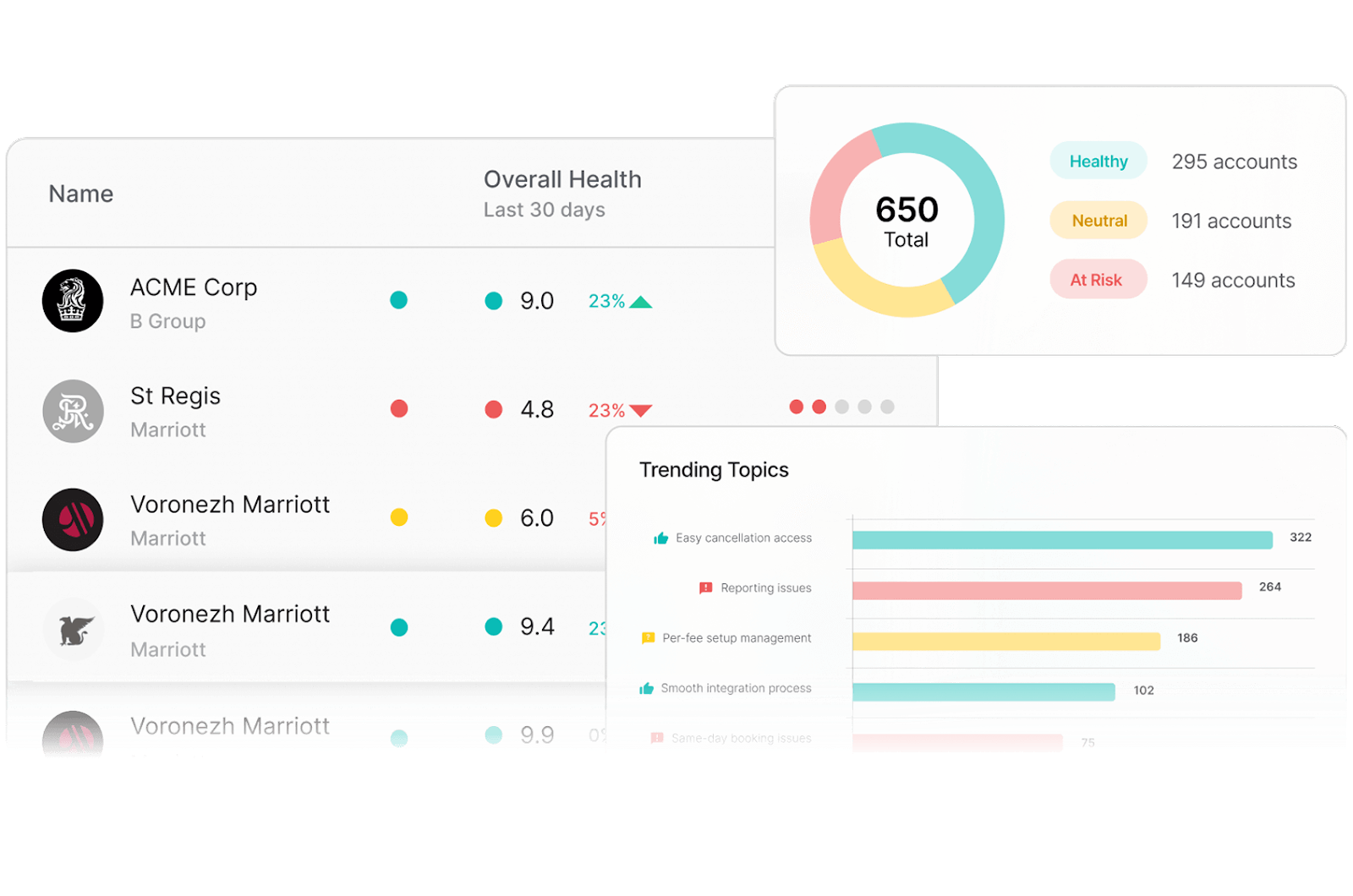
Overview
Velaris is an advanced Customer Success platform specifically designed to support Customer Success teams with AI-powered insights, task automation, and post-sales success.
Unlike traditional CRMs, which focus primarily on the sales cycle, Velaris enables CSMs to proactively manage and optimize the entire post-sales journey. This includes everything from onboarding to renewals, offering deep visibility into customer health, usage patterns, and overall satisfaction.
What makes Velaris stand out is its ability to seamlessly integrate AI-driven features such as customer health scores, churn prediction, and automated workflows. With Velaris, CSMs can anticipate potential issues, identify upsell opportunities, and ensure that customers are deriving maximum value from the product or service.
Key Features
- AI-Driven Customer Health Scores: Velaris automatically generates health scores based on customer data such as product usage, support tickets, and overall engagement. This gives CS teams real-time insights into which customers are at risk and which accounts are primed for upsell opportunities.
- Churn Predictions: Using predictive analytics, Velaris forecasts potential churn risks by identifying behavioral patterns, allowing teams to intervene proactively and mitigate customer loss.
- Task Automation: Velaris automates key tasks like follow-up emails, reminders, and task assignments. This allows CSMs to focus on strategic activities, improving their efficiency and reducing manual work.
- Centralized Dashboard: Velaris’ dashboard consolidates all customer data, providing a clear overview of customer health, usage patterns, and engagement. This gives CSMs easy access to all the information they need to manage customer relationships effectively.
- Integration with Salesforce, HubSpot, and More: Velaris integrates seamlessly with major CRMs and tools like Salesforce and HubSpot, making it easier for CS teams to align their workflows with other departments.
Best For
Velaris is ideal for B2B SaaS companies and larger Customer Success teams looking for an all-in-one AI-powered platform to manage and optimize the post-sales customer journey. Velaris is especially beneficial for companies dealing with complex customer interactions or high-volume accounts, where AI-driven insights can drive significant efficiencies.
Pros and Cons
Pros:
- AI-Powered Insights: Velaris uses AI to generate accurate customer health scores and predict churn risks, giving CS teams the tools to act proactively.
- Task Automation: Automating routine tasks like follow-up emails and reminders saves time and helps teams focus on high-impact activities.
- Comprehensive Support: Velaris provides excellent customer support throughout the customer journey, offering dedicated CSMs, slack channels, and weekly catchup calls, which ensures your team gets the most out of the platform’s features.
- Seamless Integration: The platform integrates smoothly with other tools due to Velaris Bridge, which is a low-code integration builder that allows easy custom integrations.
Cons:
- Learning Curve: Due to its comprehensive features, Velaris may have an initial learning curve for new users. The platform’s full potential can take some time to unlock, especially for teams that are new to AI-powered tools.
- Best Suited for Mid-to-Large Teams: Velaris is designed with advanced AI and automation capabilities, making it better suited for mid-to-large teams that require a robust solution for customer success management.
Pro Tip for CS Teams:
Make the most of the customer portal: Connect by Velaris. This allows you to streamline onboarding and implementation by providing customers with a shared space inside your product. This portal allows for shared task management, enabling customers to collaborate on project milestones, upload files securely, and access an embedded widget for easy communication.
2. ChatGPT / LLMs (Large Language Models)

Overview
ChatGPT and other LLMs (Large Language Models) are AI-powered tools designed to enhance customer communication by automating responses, analyzing customer sentiment, and offering actionable insights in real time.
For CSMs, these tools serve as an essential part of scaling customer interactions without sacrificing personalization or quality.
The ability of LLMs to understand context, provide responses based on past interactions, and integrate into various channels (live chat, emails, etc.) makes them a powerful asset for Customer Success teams in any industry.
Key Features
- AI-driven Chatbots: ChatGPT and other LLMs power intelligent chatbots that provide real-time, human-like responses to customer inquiries. These bots, when integrated into other tools, can be programmed to handle a wide variety of customer needs, from basic information requests to product troubleshooting and common inquiries, providing 24/7 support without needing human involvement.
- Automated Email Replies: LLMs are capable of handling automated email responses, enabling Customer Success teams to reply promptly to customer questions and issues. These AI-powered emails are tailored to each customer's query, reducing response time and improving customer satisfaction by providing fast and relevant information.
- Sentiment Analysis: One of the most valuable features of LLMs is their ability to perform sentiment analysis. By analyzing the emotional tone of customer communications, LLMs help CSMs understand the level of customer satisfaction, whether a customer is satisfied, frustrated, or confused. This enables teams to prioritize responses and take immediate action when dealing with at-risk customers.
- Language-Based Insights: LLMs can also extract valuable insights from conversations, such as detecting recurring issues, customer pain points, and feedback about product features. This allows CS teams to better understand the customer experience, identify improvement areas, and take proactive steps to enhance the customer journey.
Best For
ChatGPT and LLMs are best for Customer Success teams that need to automate communication, manage customer support tickets, and engage with large volumes of customers. These tools are particularly helpful for businesses that experience high customer interaction volumes, as they allow CSMs to handle routine inquiries efficiently.
Pros and Cons
Pros:
- Automation of Basic Inquiries: ChatGPT and LLMs excel at handling basic customer inquiries, enabling CS teams to focus on more complex issues or higher-touch interactions.
- Improved Response Time: With AI automating responses, customer queries are answered almost immediately, improving response time and customer satisfaction.
- Scalable Communication: LLMs can manage multiple customer interactions simultaneously, making it easier for CS teams to scale engagement efforts without increasing headcount.
- Sentiment Detection: By providing real-time sentiment analysis, LLMs help CSMs gauge customer emotions and prioritize urgent follow-ups, which helps reduce churn and improve retention.
Cons:
- Lack of Human Empathy: While LLMs can provide helpful information and support, they lack the human empathy needed to handle complex, emotionally sensitive situations. In cases of frustration or dissatisfaction, customers may prefer interacting with a human representative.
- Potential for Misunderstandings: LLMs may misinterpret customer queries or fail to grasp the nuances of a conversation. Without human oversight, this can lead to incorrect responses or misunderstandings.
- Need for Fine-Tuning: To ensure the highest quality responses, LLMs require regular fine-tuning. They must be updated with relevant data, feedback, and customer queries to stay relevant and effective. Poorly tuned AI models may result in irrelevant or unhelpful answers.
Pro Tip for CS Teams:
Implement ChatGPT to automate responses for frequent customer queries like password resets, billing inquiries, and simple troubleshooting. By integrating it with your customer support platform, you can use ChatGPT for ticket triage to prioritize high-impact cases and improve response times.
3. Gong
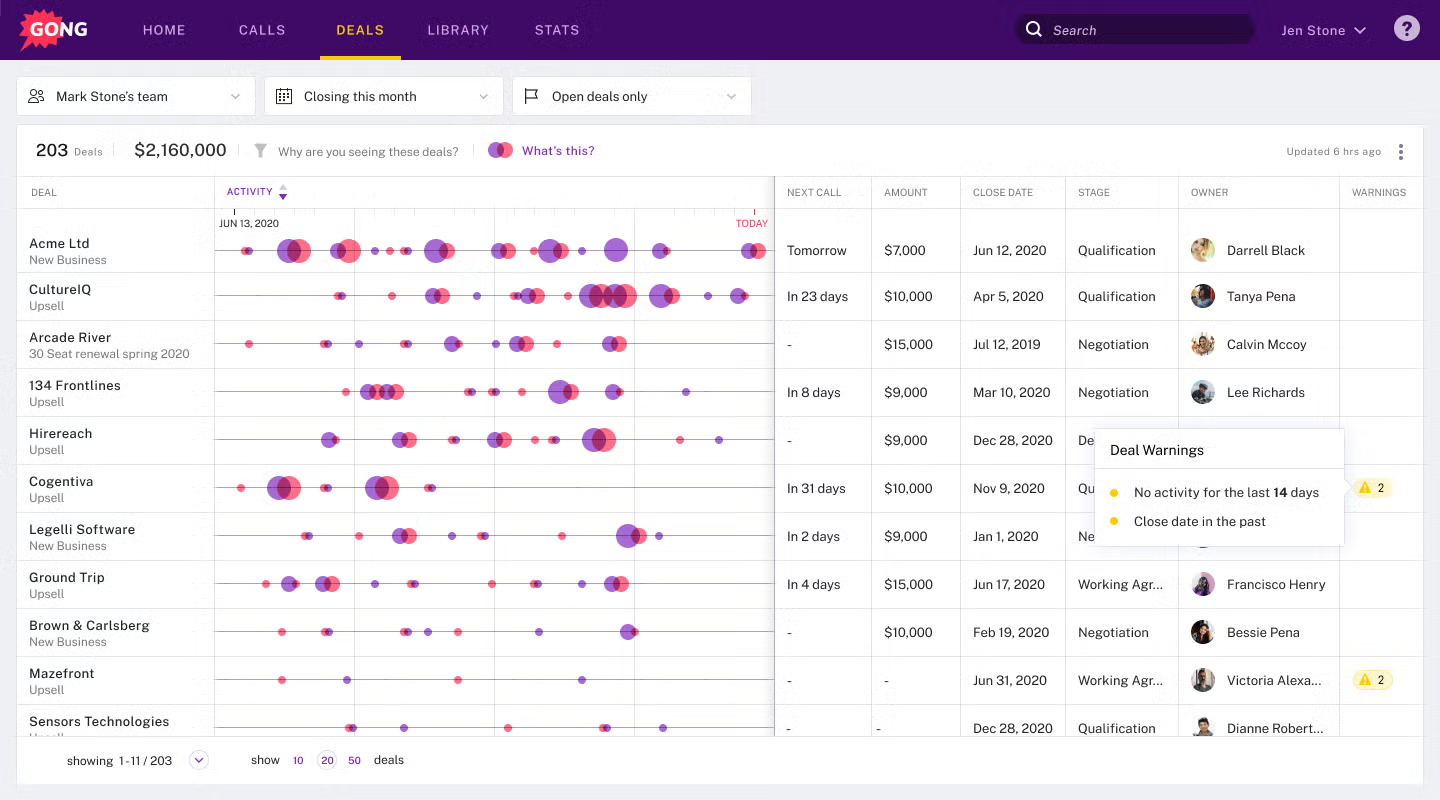
Overview
Gong is an AI-powered conversation analytics tool designed to enhance customer interactions for both sales and Customer Success (CS) teams. Gong’s AI-driven insights enable teams to analyze customer conversations across various channels (calls, emails, meetings) and uncover actionable data.
Gong is especially useful for businesses in the SaaS, B2B, and enterprise sectors, helping teams leverage conversation intelligence to improve engagement, retention, and sales performance.
Key Features
- AI-driven Conversation Analysis: Gong’s AI analyzes every customer interaction and extracts important insights from the conversation, such as objections, commitments, and feedback. This helps Customer Success teams optimize their communication strategies and focus on high-value interactions.
- Sentiment Tracking: Gong’s sentiment analysis feature detects the emotional tone of customer interactions in real-time. By understanding whether customers are feeling positive, negative, or neutral, CS teams can prioritize responses based on urgency, ultimately reducing churn and improving customer satisfaction.
- Performance Coaching: Gong’s AI-powered performance coaching tool evaluates team member performance, identifying areas of improvement. It automatically scores conversations, highlights effective communication strategies, and offers actionable suggestions for improvement. This feature ensures that CS teams are constantly improving their engagement techniques.
- Conversation Intelligence Dashboard: Gong’s intelligent dashboard provides a clear, visual representation of all customer interactions, with insights into trends, customer sentiment, and team performance. It helps CS teams stay aligned with customer success goals and make data-driven decisions to improve engagement.
Best For
Sales teams and Customer Success Managers looking to enhance customer communication with AI-powered insights. Gong is best suited for teams focused on customer retention, growth, and upselling by analyzing past customer interactions. It is particularly beneficial for large organizations or teams handling multiple customer interactions across channels.
Pros and Cons
Pros:
- Deep AI Insights: Gong provides deep insights into customer behavior and conversation quality, making it an excellent tool for CS teams focused on improving retention and engagement.
- Real-Time Alerts: Gong’s AI-powered alerts notify teams when a critical customer moment occurs, such as a risk of churn or an upsell opportunity. This ensures timely interventions.
- Improved Team Performance: Gong’s performance coaching feature uses AI to provide tailored feedback, improving CSM efficiency and communication strategies.
- Integration with CRM Platforms: Gong integrates seamlessly with Salesforce, HubSpot, and other CRMs, allowing teams to incorporate conversation data directly into their customer records, improving workflow management.
Cons:
- Initial Setup: Gong requires a significant setup period, especially for large teams. Its full integration into existing workflows can take time and may require technical support.
- Cost: The platform can be on the higher end of the price spectrum, making it potentially out of reach for smaller teams or businesses on a budget.
- Data Quality Dependence: Gong’s AI analysis relies on the quality of conversation data. Low-quality audio or incomplete transcripts may reduce the tool’s effectiveness, especially in situations with background noise or poor transcription accuracy.
Pro Tip for CS Teams:
Leverage Gong’s sentiment tracking and AI insights to prioritize high-risk customers who show signs of dissatisfaction or frustration in their conversations. By identifying these issues early, CS teams can proactively reach out to resolve concerns before they escalate, significantly improving customer retention.
4. ChurnZero
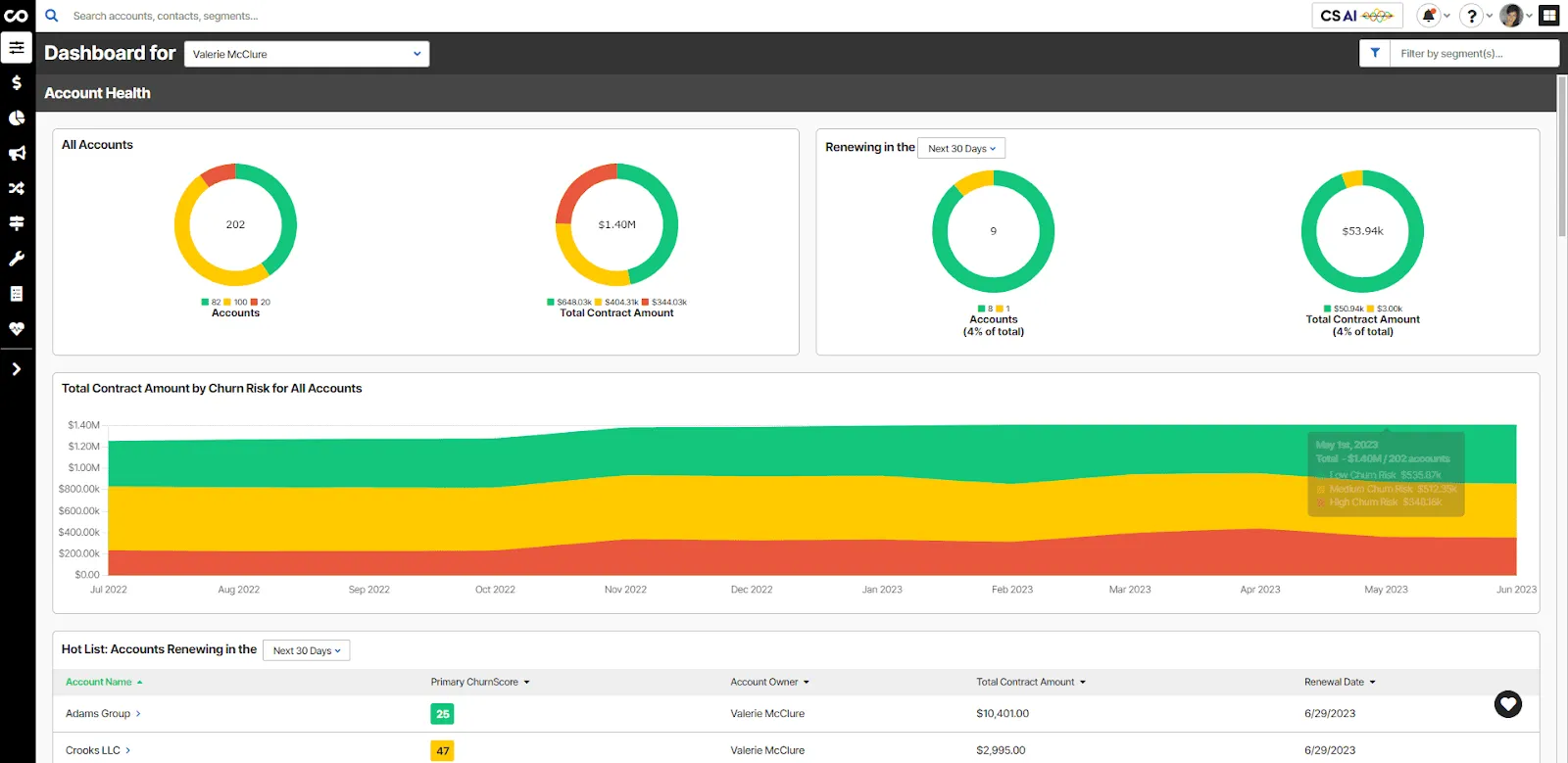
Overview
ChurnZero is an AI-powered Customer Success platform designed to help businesses monitor customer engagement, predict churn, and automate communication. Focused on subscription-based businesses, ChurnZero allows CSMs to easily track customer health, measure product usage, and identify at-risk customers before they churn..
ChurnZero integrates with popular CRM tools like Salesforce and HubSpot, as well as customer support platforms, ensuring that all customer data and interactions are consolidated in one place.
Key Features
- Customer Health Scoring: ChurnZero's AI-driven customer health scoring helps CSMs identify the likelihood of a customer churning based on various metrics such as product usage, support tickets, and satisfaction levels.
- Automated Engagement Workflows: ChurnZero offers automation tools that allow teams to create customized workflows for customer engagement. These workflows can automatically trigger emails, reminders, or in-app messages based on specific customer behaviors, ensuring consistent and timely outreach.
- Real-Time Alerts and Notifications: ChurnZero provides real-time alerts for churn risks, so CSMs can quickly intervene when a customer is showing signs of disengagement. These alerts are based on the health scores and customer behavior patterns that the AI identifies, helping teams prioritize their efforts efficiently.
- In-App Messaging: With ChurnZero’s in-app messaging feature, CSMs can communicate with customers directly within the product, offering guidance, support, or upsell opportunities.
- Integration with CRMs and Other Tools: ChurnZero integrates with Salesforce, HubSpot, and other tools, ensuring synchronization of customer data. These integrations help CSMs leverage all available information to create personalized, targeted customer success plans.
Best For
ChurnZero is best suited for subscription-based businesses (SaaS, media, e-commerce, etc.) that need to focus on retention, reducing churn, and improving customer health. Teams looking to manage a high volume of customer accounts will benefit greatly from ChurnZero’s automated features and AI-driven alerts.
Pros and Cons
Pros:
- AI-Driven Insights: ChurnZero’s customer health scoring and churn predictions provide valuable insights, helping CSMs identify at-risk customers before it’s too late.
- Real-Time Alerts: The real-time alerts ensure that CSMs are always aware of potential churn risks, allowing them to intervene proactively and prevent customer loss.
- Customizable Automation: The automation capabilities enable teams to set up tailored workflows for different customer segments, ensuring the right engagement at the right time.
Cons:
- Complexity for New Users: While ChurnZero is powerful, it can be complex for new users. Onboarding and training may take time for teams to fully understand how to set up and utilize its many features.
- Limited Reporting Features: While ChurnZero offers great automation and insights, its reporting features can be somewhat limited compared to more advanced platforms like Velaris or Salesforce.
- Higher Pricing for Smaller Teams: ChurnZero’s pricing can be a barrier for smaller teams or startups, especially when compared to more budget-friendly options. The platform’s pricing is tailored for medium-to-large businesses with complex needs.
Pro Tip for CS Teams:
Use ChurnZero’s real-time alerts to keep track of customer health and automate follow-up workflows based on customer behavior. By focusing on customers who are showing signs of disengagement, you can proactively engage and retain at-risk accounts, driving long-term loyalty and satisfaction.
5. Beautiful.ai
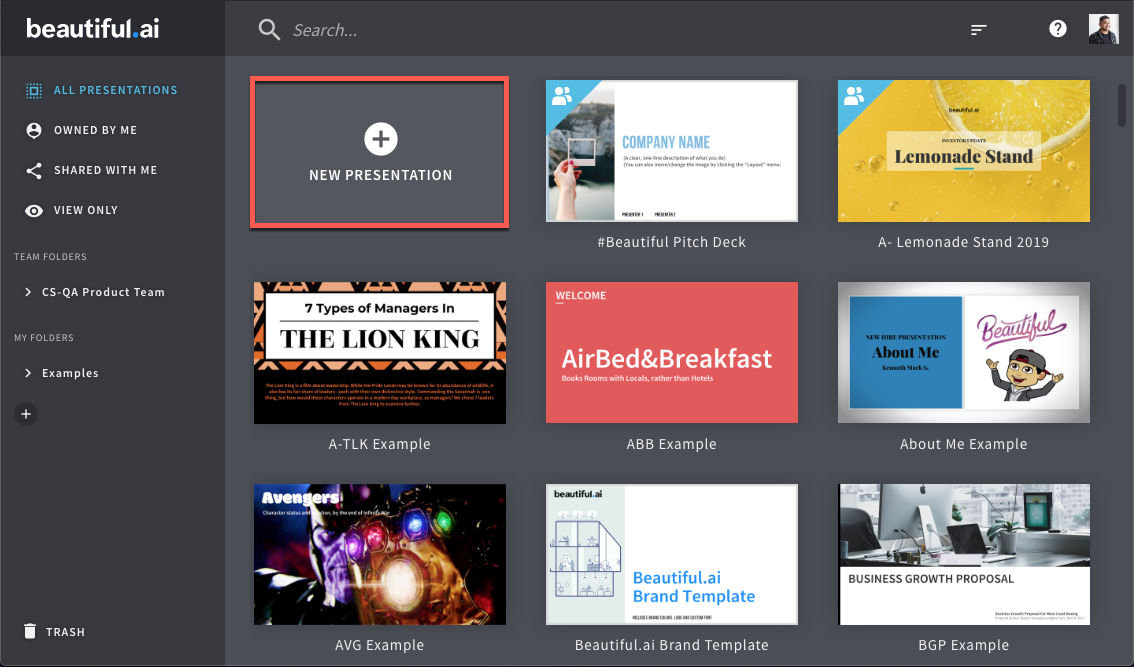
Overview
Beautiful.ai is an AI-powered presentation tool designed to help teams quickly create visually compelling and data-driven presentations. Although it's not specifically tailored for Customer Success, Beautiful.ai stands out as a valuable tool for CS teams that need to communicate insights and results in a visually engaging format.
Customer Success teams often need to deliver QBRs (Quarterly Business Reviews), onboarding presentations, and internal performance updates, and Beautiful.ai makes this process easier by offering AI-driven design features that streamline the creation of professional, high-quality slides.
Key Features
- AI-Powered Design: Beautiful.ai’s AI automatically adjusts the layout of your slides as you add content, ensuring a professional, polished look without needing design expertise. This feature allows CS teams to create impactful presentations that focus on data-driven insights without wasting time on formatting.
- Customizable Templates: Beautiful.ai offers customizable templates that are specifically designed for different types of business presentations, including customer success metrics, customer feedback, and health scores. These templates save time and ensure consistency across presentations.
- Collaboration Tools: Beautiful.ai supports team collaboration in real-time, allowing multiple members of the Customer Success team to work on a presentation simultaneously. Whether you're preparing a customer review meeting or internal performance report, this feature ensures that everyone is aligned and can contribute effectively.
- Cloud-Based: Being cloud-based means that all presentations are automatically saved, making it easy to access, edit, and share presentations at any time and from any location. This is ideal for remote teams or CSMs working across multiple time zones.
Best For
Beautiful.ai is best for Customer Success teams looking to enhance their customer-facing presentations and internal reports. It is particularly effective for CS teams who regularly need to present QBRs, customer success metrics, and performance reports to internal or external stakeholders.
Pros and Cons
Pros:
- AI-Powered Automation: Beautiful.ai removes the need for manual slide formatting and design, allowing CSMs to focus on the content rather than the design, saving time and effort.
- Data Visualizations: Built-in data visualizations allow CS teams to present insights in a way that is visually appealing and easy to understand.
- Collaboration Features: The real-time collaboration features enable teams to work together on presentations, improving efficiency and reducing the time spent on content creation.
Cons:
- Limited Interactivity: While Beautiful.ai provides great visuals, it lacks the interactivity and dynamic features of some advanced tools like PowerPoint or Prezi. This might be a drawback if your team requires highly interactive presentations.
- Not Customer Success Specific: Beautiful.ai is a general-purpose presentation tool, so it doesn’t offer specific features designed for Customer Success teams (e.g., health score tracking or churn prediction). CSMs will need to manually input data or use integrations to pull in the right metrics.
- Pricing: For advanced features and team collaboration, the platform may be on the more expensive side compared to other simple presentation tools. For teams with tight budgets, this could be a limiting factor.
Pro Tip for CS Teams:
Use Beautiful.ai’s template library to quickly create customer success reports and quarterly business reviews (QBRs). Customize the templates to include key success metrics like customer health scores, product usage, and NPS.
6. Zendesk
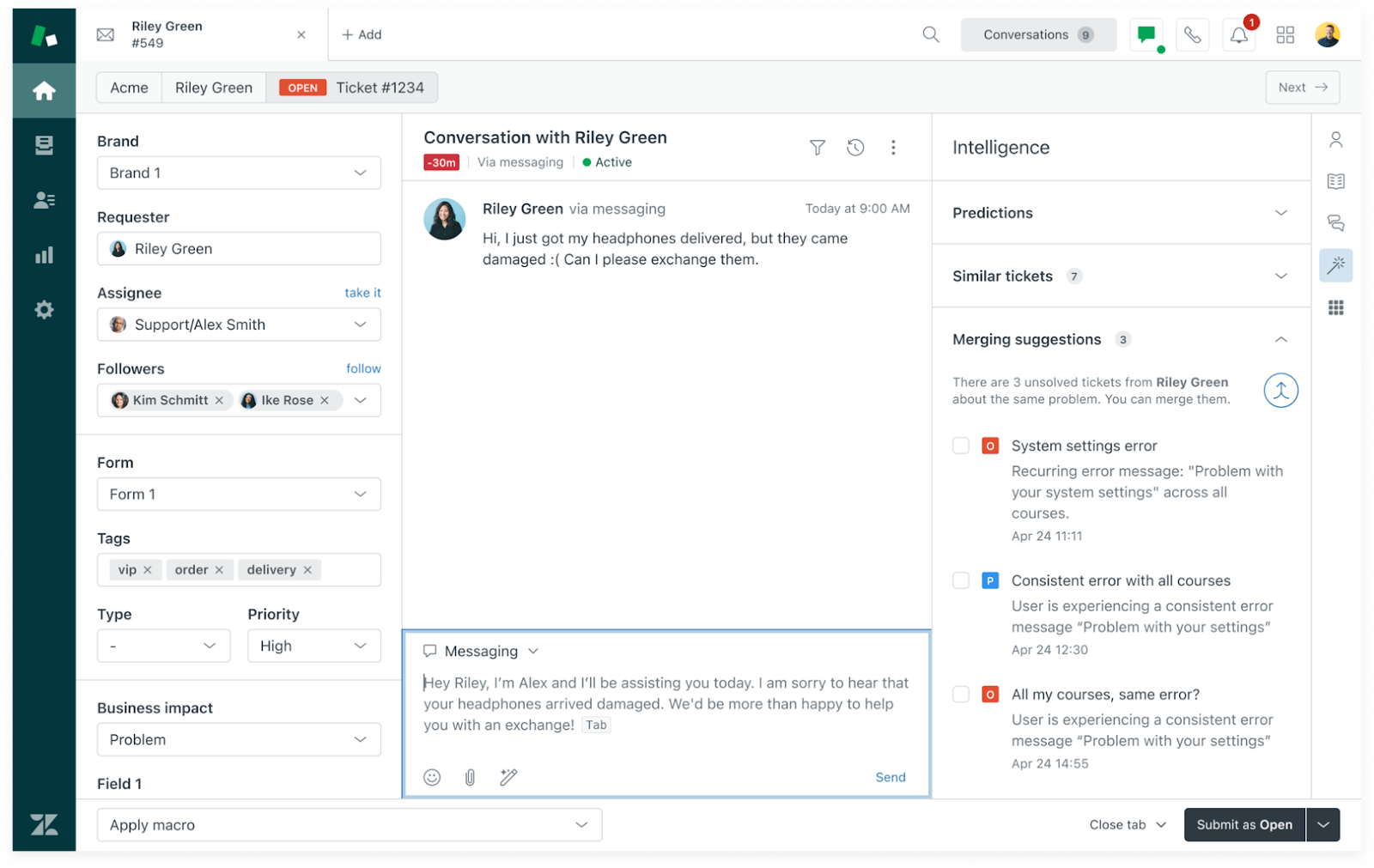
Overview
Zendesk is a well-known customer support platform that uses AI to enhance both customer service and Customer Success workflows. It’s designed to help businesses efficiently manage customer inquiries and improve the overall customer experience.
What sets Zendesk apart is its ability to blend customer service and success functions in one comprehensive platform. It allows CS teams to manage customer inquiries, track satisfaction, and improve communication.
Key Features
- AI-Driven Ticketing System: Zendesk’s AI-powered ticketing system automatically categorizes, prioritizes, and assigns customer queries based on the issue type, urgency, and customer profile. This allows CS teams to respond faster and ensures that critical issues are addressed immediately.
- Automated Responses: Zendesk’s automated response system helps businesses quickly resolve basic inquiries and FAQs without human intervention. AI-driven chatbots and email templates can assist customers, leaving CSMs free to focus on more complex cases or proactive engagements.
- Customer Satisfaction Tracking: With Zendesk, CS teams can track customer satisfaction through post-interaction surveys and customer feedback analysis. The platform uses AI to analyze customer responses, enabling teams to identify trends, monitor customer sentiment, and take action accordingly.
- Advanced Reporting and Analytics: Zendesk provides reporting tools that give CS teams insight into performance metrics, including ticket volume, resolution times, and customer satisfaction. The platform’s analytics capabilities are built to help teams spot areas for improvement and measure the effectiveness of their customer success strategies.
Best For
Zendesk is ideal for businesses that require a comprehensive customer support and success platform. It’s especially beneficial for teams seeking to automate ticketing workflows, improve customer satisfaction, and streamline communication with customers.
Pros and Cons
Pros:
- User-Friendly Interface: Zendesk’s easy-to-use interface allows Customer Success Managers (CSMs) and support agents to get started quickly, without extensive training.
- Robust Features: With its AI-driven ticketing system, automated responses, and customer satisfaction tracking, Zendesk provides a well-rounded solution for both customer support and customer success teams.
- Seamless Integrations: Zendesk integrates with popular platforms like Salesforce, HubSpot, and Slack, making it easy to incorporate into existing workflows and ensure cross-functional alignment between sales, support, and success teams.
- Customizable Reports: Zendesk provides detailed reporting and analytics tools, which can help CSMs track key performance metrics and make data-driven decisions.
Cons:
- Lacks Advanced Analytics: While Zendesk’s analytics capabilities are robust, they may not be as in-depth or customizable as some specialized Customer Success tools like Velaris. More granular insights may require additional integrations or third-party tools.
- Complexity for Larger Teams: As businesses scale, Zendesk’s pricing can become prohibitive for large teams. The complexity of managing multiple accounts and teams across departments might require additional setup or configuration, which could be a barrier for smaller businesses or startups.
- Limited Customization: Zendesk offers good customization but is somewhat less flexible compared to more dedicated Customer Success platforms. Businesses with very specific requirements may find it harder to tailor the platform to their exact needs without additional custom development.
Pro Tip for CS Teams:
Leverage Zendesk’s automated responses and ticketing system to streamline customer inquiries and focus on higher-value tasks. Use the customer satisfaction tracking feature to regularly assess and improve your team’s performance, ensuring that every customer interaction is optimized for long-term success.
7. Momentum

Overview
Momentum is an an AI-native Revenue Orchestration Platform that automates workflows and data entry for Go-To-Market (GTM) teams (sales, customer success, RevOps, etc.). It integrates with existing tools like Salesforce and Slack to turn unstructured customer interactions (calls, emails, chats) into structured data and automated actions.
Key Features
- Deal Execution & Intelligence Agents: Momentum is able to automate CRM updates and administrative work (via Autopilot/Retropilot) while providing real-time alerts (AI Signals) and conversational data lookups (Ask Momentum).
- Content & Coaching Agents: It also can automatically create short, shareable video highlights (SmartClips) and provides AI Sales Coaching with competency reviews and methodology briefs.
- Reporting & Collaboration: The platform also generates synthesized, audience-specific reports (Account & Executive Briefs) and centralizes team communication via Deal Rooms & Account Rooms (AI-powered Slack channels).
- AI Data Pipeline (Underlying Core): The foundation that automatically extracts, synthesizes, and synchronizes key data from all customer interactions (calls, emails, tickets) directly into systems like Salesforce and Slack.
Best For
Momentum is best for B2B sales and Customer Success teams that want to streamline deal collaboration, automate updates in their CRM, and keep revenue teams aligned in Slack or Microsoft Teams. It is especially useful for organizations with long, complex sales cycles involving multiple stakeholders, where maintaining context and timely communication is essential.
Pros and Cons
Pros:
- Workflow Automation: Momentum automates routine CRM tasks, such as updating deal stages, logging notes, and assigning next steps, so reps can focus on selling instead of manual data entry.
- Seamless Collaboration: By integrating directly with Slack and Microsoft Teams, Momentum keeps Sales, CS, and RevOps teams aligned without needing constant CRM check-ins. Team members can discuss deals, tag colleagues, and trigger workflows directly from chat.
- Improved Deal Visibility: Momentum provides real-time visibility into deal progress, ensuring that everyone involved, from AEs to executives, stays informed on pipeline health and next steps.
- Custom Playbooks: Teams can configure deal playbooks to automate handoffs, enforce sales processes, and trigger alerts when deals go stale or require action.
Cons:
- Learning Curve for Setup: While easy to use once implemented, configuring workflows and integrations may require initial support from RevOps or Sales Ops teams.
- Limited Offline Functionality: As a chat-driven tool, Momentum’s utility decreases when teams are not active in Slack or Teams environments.
- Integration Depth: Momentum works great with Salesforce, but organizations using HubSpot or other CRMs won’t find value in the solution since they haven’t built integrations with those CRMs yet.
Pro Tip for CS Teams:
Use Momentum to automate deal updates and renewal reminders within Slack or Microsoft Teams. Set up triggers to alert account managers when renewal dates approach, key decision-makers change, or deal stages shift, ensuring no opportunity slips through the cracks and your revenue team stays fully synchronized.
8. WalkMe
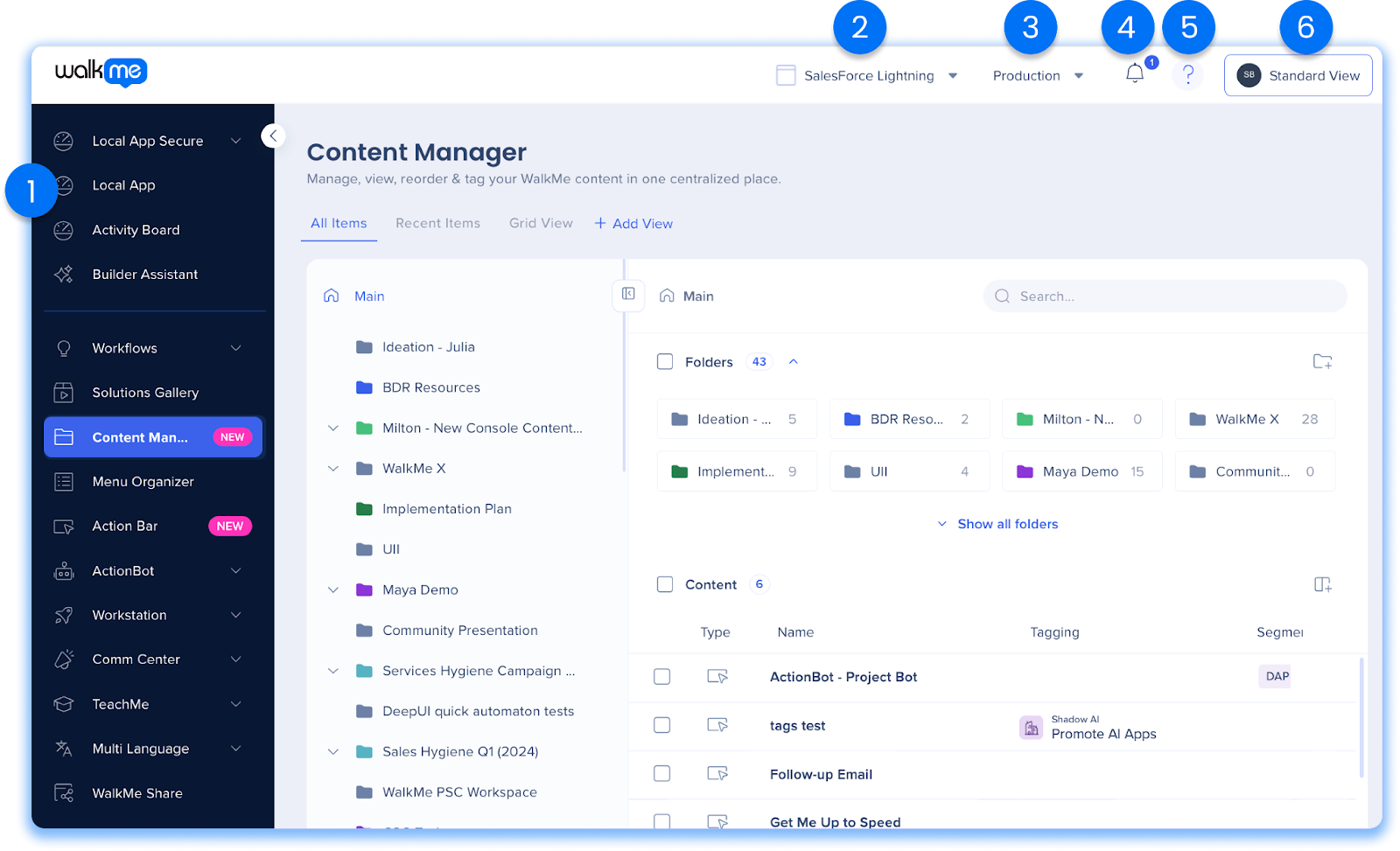
Overview
WalkMe is an AI-powered digital adoption platform designed to improve user onboarding and engagement by providing interactive guidance within software applications. WalkMe offers businesses the ability to create a seamless, personalized onboarding experience for new users, ensuring they understand how to navigate the product and fully leverage its features.
WalkMe’s focus on in-app engagement sets it apart from traditional CRM and Customer Success platforms, as it emphasizes the user’s interaction with the product itself rather than just customer interactions or data.
Key Features
- AI-Driven Guidance: WalkMe provides AI-driven onboarding guides that offer real-time, step-by-step instructions to users as they interact with a product. These guides ensure users receive contextual help exactly when they need it, without disrupting their workflow.
- In-App Tutorials: WalkMe offers interactive tutorials within the application itself, allowing users to go through self-paced training sessions or product walkthroughs. These tutorials ensure that users understand how to perform tasks effectively, boosting user confidence and product adoption.
- User Behavior Analytics: WalkMe uses AI to track user behavior within the product, providing businesses with insights into how users interact with specific features, where they may struggle, and what parts of the product are underutilized.
- Personalized User Journeys: WalkMe can personalize the onboarding process based on the user’s role, behavior, and progress within the product. By offering a customized experience, CS teams can ensure that each user receives the right level of support and guidance, which accelerates their time-to-value with the product.
Best For
WalkMe is best suited for organizations looking to enhance user adoption through AI-powered in-app guidance. It’s especially beneficial for businesses with complex software solutions or high user turnover, where personalized and efficient onboarding is critical to retaining and engaging users.
Pros and Cons
Pros:
- Personalized Onboarding: WalkMe provides customized, AI-driven onboarding experiences, helping users get acquainted with the product and increasing adoption rates.
- Real-Time, Contextual Assistance: The in-app tutorials and guides offer real-time support, reducing friction and confusion while users learn to navigate the product.
- Seamless Integration: WalkMe integrates with various applications and platforms, allowing businesses to deliver a consistent, smooth experience across the product.
Cons:
- Requires Customization: While WalkMe provides excellent out-of-the-box features, its personalization options may require customization to fully align with the specific needs of a business. Implementing and fine-tuning the tool for each organization can be time-consuming and may require technical expertise.
- Potential Complexity for Smaller Teams: For smaller teams or businesses with less complex products, WalkMe may be overkill. The platform's full potential is realized when dealing with larger teams or products with high user volume.
- Pricing: As a robust platform for user adoption, WalkMe can be pricey for startups or smaller organizations. The cost may not be justifiable for businesses with simpler customer success needs or fewer users to onboard.
Pro Tip for CS Teams:
First leverage WalkMe’s personalized journeys to guide new users through onboarding processes and encourage them to explore key features. Then use the analytics to identify users who might not be engaging with critical product features, and proactively reach out to provide additional training or resources to help boost their adoption.
9. SurveySparrow

Overview
SurveySparrow is an AI-powered survey and feedback platform designed to help businesses collect valuable customer insights. By offering a range of survey options and leveraging AI-driven analytics, SurveySparrow enables CSMs to gather actionable feedback that can be used to drive improvements in customer engagement, satisfaction, and retention.
With its user-friendly interface and customizable survey options, SurveySparrow simplifies the feedback collection process, making it easier for businesses to engage with customers and gain deep insights into their needs.
Key Features
- AI-Driven Sentiment Analysis: SurveySparrow utilizes AI-powered sentiment analysis to analyze the emotional tone of customer responses. This helps CS teams understand not just what customers are saying, but also how they feel about specific aspects of the product, service, or experience. By identifying positive, negative, and neutral sentiment, teams can prioritize follow-up actions more effectively.
- Customizable Surveys: SurveySparrow offers a wide variety of customizable survey templates. Whether you’re measuring customer satisfaction, gathering feedback after an onboarding session, or tracking engagement after a product update, SurveySparrow allows you to design surveys that fit your goals.
- Real-Time Feedback Tracking: With SurveySparrow, businesses can track customer feedback in real time. As customers submit responses, CS teams can immediately access the data and start analyzing trends, identifying issues, and taking action. This instant feedback loop helps teams stay agile and responsive to customer concerns.
- Multi-Channel Feedback Collection: SurveySparrow supports a variety of feedback collection methods, including email surveys, SMS surveys, and web-based forms.
Best For
SurveySparrow is especially beneficial for businesses that want to track customer sentiment, measure product satisfaction, and improve customer retention by understanding the customer experience.
Pros and Cons
Pros:
- Easy to Use: SurveySparrow has a user-friendly interface, making it easy for CS teams to create, distribute, and analyze surveys without needing technical expertise. The platform is intuitive, allowing teams to quickly set up and start collecting feedback.
- Customization: SurveySparrow allows teams to tailor surveys to their specific needs, ensuring that they can gather the exact data they need to improve customer success strategies.
- Multi-Channel Support: The ability to collect feedback across different channels (email, SMS, web) ensures that CS teams can engage customers wherever they are and gather a more comprehensive set of insights.
Cons:
- Integration with Other Tools Needed for Comprehensive Analysis: While SurveySparrow offers great survey and sentiment analysis capabilities, businesses may need to integrate it with other tools (like CRM or Customer Success platforms) for a more comprehensive view of customer data and feedback.
- Limited Advanced Features: For teams that require more sophisticated analytics or advanced reporting, SurveySparrow may not offer a great depth of features. Businesses looking for complex churn analysis or predictive insights may find SurveySparrow less comprehensive.
- Survey Fatigue: Like any survey-based tool, there is the potential for survey fatigue among customers. Repeatedly requesting feedback from the same customer base can result in lower response rates over time. CS teams need to manage this aspect to ensure they maintain high-quality data.
Pro Tip for CS Teams:
Use SurveySparrow’s survey triggers to automatically send targeted feedback surveys at key touchpoints in the customer journey, such as after onboarding, a product update, or a support interaction.
10. Userpilot

Overview
Userpilot is a product experience platform that uses AI-driven personalization to enhance user onboarding and in-app experiences. It helps businesses create tailored user journeys within their product by leveraging real-time user data, behavior analytics, and AI to guide users through a more engaging, frictionless experience. Unlike traditional onboarding tools,
For CSMs, Userpilot offers a unique solution to improve product adoption and user engagement. It provides the ability to create customized in-app experiences that ensure users are able to navigate the product, understand key features, and ultimately become more proficient users.
Key Features
- AI-Driven Personalization: Userpilot leverages AI to deliver personalized in-app experiences. By analyzing user behavior, the platform dynamically adjusts the content, messages, and guidance shown to users, ensuring they receive the most relevant information at the right time.
- User Segmentation: Userpilot allows you to segment users based on their behavior, progress, and interaction patterns within the product. This segmentation enables Customer Success teams to target specific user groups with tailored onboarding, product tours, and feature introductions based on their individual needs and use cases.
- Behavior Analytics: Userpilot’s behavior analytics track how users interact with the product, providing valuable insights into user engagement. CS teams can use this data to understand which features are most utilized, which areas of the product might need additional focus, and where users may be struggling.
- In-App Feedback Collection: The platform allows businesses to collect real-time feedback directly within the app. This can be used to gather insights on user satisfaction, identify pain points, and act on customer feedback quickly.
Best For
Userpilot is best for SaaS companies and Customer Success teams looking to optimize user onboarding and improve product engagement through AI-powered solutions. It is particularly useful for teams that want to provide a personalized onboarding experience for new users, ensure that customers are using key features, and proactively drive product adoption. If your company has complex or feature-rich products, Userpilot helps ensure that users don’t miss out on essential features or capabilities.
Pros and Cons
Pros:
- Seamless User Onboarding: Userpilot streamlines the onboarding experience by providing in-app guidance, helping users get acquainted with the product quickly. This smooth onboarding process ensures higher adoption rates and reduces the risk of user churn.
- Enhanced User Retention: Userpilot’s AI-driven features not only improve product adoption but also help in increasing user retention by ensuring that users stay engaged and are continuously guided towards product features that offer the most value.
- Scalable Personalization: With Userpilot, teams can easily scale their efforts to deliver personalized experiences across a growing user base. The platform allows for tailored experiences at scale, ensuring that as user numbers grow, the quality of experience remains consistent and high.
- Proactive Support: Userpilot’s ability to track user activity helps identify potential challenges early. By setting up automatic prompts or providing contextual support, CSMs can take a proactive approach in assisting users before issues become problems.
Cons:
- Implementation Time: Userpilot can take time to fully implement, especially for businesses with complex products. While the platform offers a lot of customization, setting up the personalized journeys and behavior analytics can require careful planning and setup.
- Learning Curve: The platform's wealth of features may pose a learning curve for teams that are new to using product experience tools. The time required for training and familiarization with the platform can impact its initial effectiveness.
- Requires Data: Since Userpilot relies on user behavior data to deliver its personalized experiences, it’s important for businesses to have a good amount of user interaction data.
Pro Tip for CS Teams:
Leverage Userpilot’s in-app feedback collection to continuously improve the onboarding experience. By gathering feedback from users at different stages of their journey, you can make data-driven decisions to enhance user engagement, reduce friction, and ensure users get the most value from your product.
Conclusion
The tools featured in this list are transforming the landscape of Customer Success (CS) by leveraging AI to automate workflows, provide predictive insights, and enable proactive customer relationship management.. Each tool, whether it’s for product adoption, customer feedback, or conversation intelligence, serves a unique purpose in streamlining customer success operations.
If you're looking for a comprehensive solution to drive customer success, Velaris offers an AI-powered platform built specifically for Customer Success Managers. Velaris integrates AI-driven insights with task automation and predictive analytics, ensuring that your team can take proactive steps to optimize customer relationships and drive long-term success.
Ready to see how Velaris can transform your team’s performance? Book a demo today to discover how Velaris can help you take your customer success efforts to the next level.
Frequently Asked Questions
The Velaris Team
A (our) team with years of experience in Customer Success have come together to redefine CS with Velaris. One platform, limitless Success.



